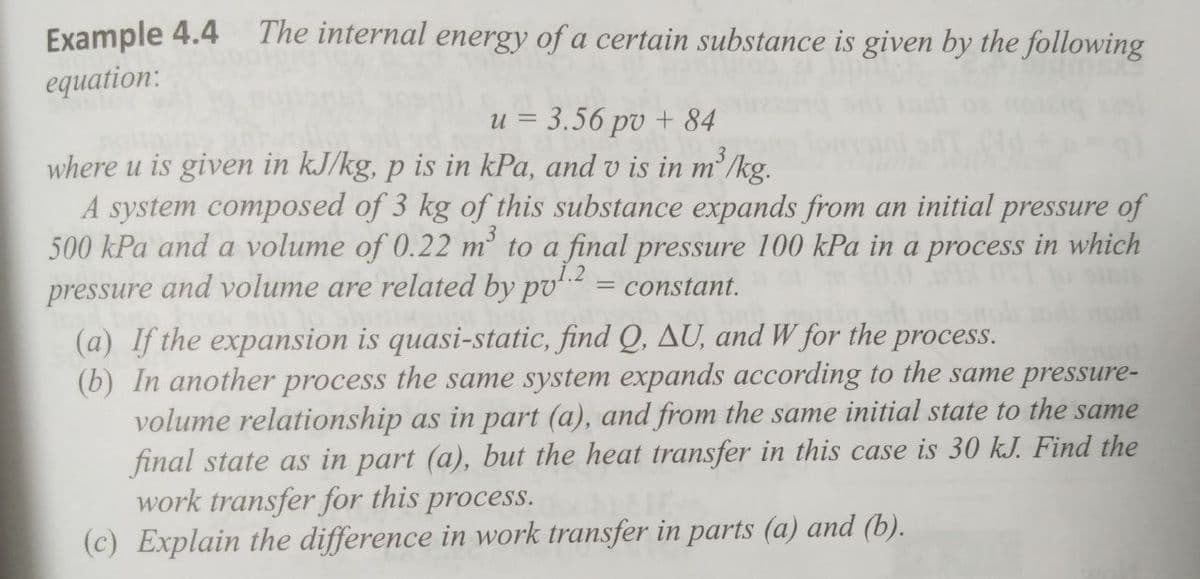(a) If the expansion is quasi-static, find Q, AU, and W for the process. (b) In another process the same system expands according to the same pressure- volume relationship as in part (a), and from the same initial state to the same final state as in part (a), but the heat transfer in this case is 30 kJ. Find the work transfer for this process. (c) Explain the difference in work transfer in parts (a) and (b).
(a) If the expansion is quasi-static, find Q, AU, and W for the process. (b) In another process the same system expands according to the same pressure- volume relationship as in part (a), and from the same initial state to the same final state as in part (a), but the heat transfer in this case is 30 kJ. Find the work transfer for this process. (c) Explain the difference in work transfer in parts (a) and (b).
Elements Of Electromagnetics
7th Edition
ISBN:9780190698614
Author:Sadiku, Matthew N. O.
Publisher:Sadiku, Matthew N. O.
ChapterMA: Math Assessment
Section: Chapter Questions
Problem 1.1MA
Related questions
Question
I need the answer quickly

Transcribed Image Text:Example 4.4
equation:
The internal energy of a certain substance is given by the following
u = 3.56 pv + 84
3
where u is given in kJ/kg, p is in kPa, and v is in m'/kg.
A system composed of 3 kg of this substance expands from an initial pressure of
500 kPa and a volume of 0.22 m to a final pressure 100 kPa in a process in which
pressure and volume are related by pv = constant.
(a) If the expansion is quasi-static, find Q, AU, and W for the process.
(b) In another process the same system expands according to the same pressure-
volume relationship as in part (a), and from the same initial state to the same
final state as in part (a), but the heat transfer in this case is 30 kJ. Find the
work transfer for this process.
(c) Explain the difference in work transfer in parts (a) and (b).
Expert Solution
This question has been solved!
Explore an expertly crafted, step-by-step solution for a thorough understanding of key concepts.
Step by step
Solved in 2 steps with 2 images

Recommended textbooks for you

Elements Of Electromagnetics
Mechanical Engineering
ISBN:
9780190698614
Author:
Sadiku, Matthew N. O.
Publisher:
Oxford University Press

Mechanics of Materials (10th Edition)
Mechanical Engineering
ISBN:
9780134319650
Author:
Russell C. Hibbeler
Publisher:
PEARSON

Thermodynamics: An Engineering Approach
Mechanical Engineering
ISBN:
9781259822674
Author:
Yunus A. Cengel Dr., Michael A. Boles
Publisher:
McGraw-Hill Education

Elements Of Electromagnetics
Mechanical Engineering
ISBN:
9780190698614
Author:
Sadiku, Matthew N. O.
Publisher:
Oxford University Press

Mechanics of Materials (10th Edition)
Mechanical Engineering
ISBN:
9780134319650
Author:
Russell C. Hibbeler
Publisher:
PEARSON

Thermodynamics: An Engineering Approach
Mechanical Engineering
ISBN:
9781259822674
Author:
Yunus A. Cengel Dr., Michael A. Boles
Publisher:
McGraw-Hill Education

Control Systems Engineering
Mechanical Engineering
ISBN:
9781118170519
Author:
Norman S. Nise
Publisher:
WILEY

Mechanics of Materials (MindTap Course List)
Mechanical Engineering
ISBN:
9781337093347
Author:
Barry J. Goodno, James M. Gere
Publisher:
Cengage Learning

Engineering Mechanics: Statics
Mechanical Engineering
ISBN:
9781118807330
Author:
James L. Meriam, L. G. Kraige, J. N. Bolton
Publisher:
WILEY